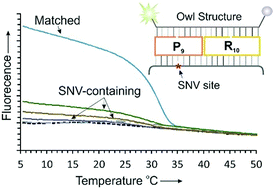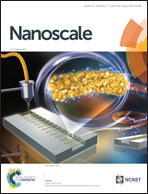The owl sensor: a ‘fragile’ DNA nanostructure for the analysis of single nucleotide variations†
Abstract
Analysis of single nucleotide variations (SNVs) in DNA and RNA sequences is instrumental in healthcare for the detection of genetic and infectious diseases and drug-resistant pathogens. Here we took advantage of the developments in DNA nanotechnology to design a hybridization sensor, named the ‘owl sensor’, which produces a fluorescence signal only when it complexes with fully complementary DNA or RNA analytes. The novelty of the owl sensor operation is that the selectivity of analyte recognition is, at least in part, determined by the structural rigidity and stability of the entire DNA nanostructure rather than exclusively by the stability of the analyte–probe duplex, as is the case for conventional hybridization probes. Using two DNA and two RNA analytes we demonstrated that owl sensors differentiate SNVs in a wide temperature range of 5 °C–32 °C, a performance unachievable by conventional hybridization probes including the molecular beacon probe. The owl sensor reliably detects cognate analytes even in the presence of 100 times excess of single base mismatched sequences. The approach, therefore, promises to add to the toolbox for the diagnosis of SNVs at ambient temperatures.



 Please wait while we load your content...
Please wait while we load your content...
